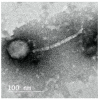Topically Applied Bacteriophage to Control Multi-Drug Resistant Klebsiella pneumoniae Infected Wound in a Rat Model
- PMID: 34572629
- PMCID: PMC8470685
- DOI: 10.3390/antibiotics10091048
Topically Applied Bacteriophage to Control Multi-Drug Resistant Klebsiella pneumoniae Infected Wound in a Rat Model
Abstract
(Background): Multi-drug-resistant Klebsiella pneumoniae (MDR-KP) has steadily grown beyond antibiotic control. Wound infection kills many patients each year, due to the entry of multi-drug resistant (MDR) bacterial pathogens into the skin gaps. However, a bacteriophage (phage) is considered to be a potential antibiotic alternative for treating bacterial infections. This research aims at isolating and characterizing a specific phage and evaluate its topical activity against MDR-KP isolated from infected wounds. (Methods): A lytic phage ZCKP8 was isolated by using a clinical isolate KP/15 as a host strain then characterized. Additionally, phage was assessed for its in vitro host range, temperature, ultraviolet (UV), and pH sensitivity. The therapeutic efficiency of phage suspension and a phage-impeded gel vehicle were assessed in vivo against a K. pneumoniae infected wound on a rat model. (Result): The phage produced a clear plaque and was classified as Siphoviridae. The phage inhibited KP/15 growth in vitro in a dose-dependent pattern and it was found to resist high temperature (˂70 °C) and was primarily active at pH 5; moreover, it showed UV stability for 45 min. Phage-treated K. pneumoniae inoculated wounds showed the highest healing efficiency by lowering the infection. The quality of the regenerated skin was evidenced via histological examination compared to the untreated control group. (Conclusions): This research represents the evidence of effective phage therapy against MDR-KP.
Keywords: Gram-negative; Klebsiella pneumoniae; antibiotics; bacteriophage; bioinformatics; immunohistochemical (IHC); in vivo; multi-drug resistance (MDR); phage characterization; phage isolation; phage therapy; wound healing; wound infection.
Conflict of interest statement
The authors declare that the research was conducted in the absence of any commercial or financial relationships that could be construed as a potential conflict of interest.
Figures








Similar articles
-
Bacteriophage as a potential therapy to control antibiotic-resistant Pseudomonas aeruginosa infection through topical application onto a full-thickness wound in a rat model.J Genet Eng Biotechnol. 2022 Sep 12;20(1):133. doi: 10.1186/s43141-022-00409-1. J Genet Eng Biotechnol. 2022. PMID: 36094767 Free PMC article.
-
Isolation, characterization, and genomic analysis of a novel bacteriophage vB_Kp_XP4 targeting hypervirulent and multidrug-resistant Klebsiella pneumoniae.Front Microbiol. 2025 Mar 7;16:1491961. doi: 10.3389/fmicb.2025.1491961. eCollection 2025. Front Microbiol. 2025. PMID: 40124894 Free PMC article.
-
Evaluation of the efficacy of a bacteriophage in the treatment of pneumonia induced by multidrug resistance Klebsiella pneumoniae in mice.Biomed Res Int. 2015;2015:752930. doi: 10.1155/2015/752930. Epub 2015 Mar 23. Biomed Res Int. 2015. PMID: 25879036 Free PMC article.
-
Multidrug-resistant Klebsiella pneumoniae: challenges for treatment, prevention and infection control.Expert Rev Anti Infect Ther. 2018 Oct;16(10):749-761. doi: 10.1080/14787210.2018.1522249. Epub 2018 Sep 19. Expert Rev Anti Infect Ther. 2018. PMID: 30207815 Review.
-
Bacteriophage as a potential biotherapeutics to combat present-day crisis of multi-drug resistant pathogens.Heliyon. 2024 Sep 5;10(18):e37489. doi: 10.1016/j.heliyon.2024.e37489. eCollection 2024 Sep 30. Heliyon. 2024. PMID: 39309956 Free PMC article. Review.
Cited by
-
Characterization of Klebsiella pneumoniae bacteriophages, KP1 and KP12, with deep learning-based structure prediction.Front Microbiol. 2023 Jan 24;13:990910. doi: 10.3389/fmicb.2022.990910. eCollection 2022. Front Microbiol. 2023. PMID: 36762092 Free PMC article.
-
Phage therapy for Klebsiella pneumoniae: Understanding bacteria-phage interactions for therapeutic innovations.PLoS Pathog. 2025 Apr 8;21(4):e1012971. doi: 10.1371/journal.ppat.1012971. eCollection 2025 Apr. PLoS Pathog. 2025. PMID: 40198880 Free PMC article. Review.
-
Topically Applied Biopolymer-Based Tri-Layered Hierarchically Structured Nanofibrous Scaffold with a Self-Pumping Effect for Accelerated Full-Thickness Wound Healing in a Rat Model.Pharmaceutics. 2023 May 17;15(5):1518. doi: 10.3390/pharmaceutics15051518. Pharmaceutics. 2023. PMID: 37242760 Free PMC article.
-
Phage vB_Ec_ZCEC14 to treat antibiotic-resistant Escherichia coli isolated from urinary tract infections.Virol J. 2024 Feb 16;21(1):44. doi: 10.1186/s12985-024-02306-0. Virol J. 2024. PMID: 38365702 Free PMC article.
-
Metronidazole Topically Immobilized Electrospun Nanofibrous Scaffold: Novel Secondary Intention Wound Healing Accelerator.Polymers (Basel). 2022 Jan 23;14(3):454. doi: 10.3390/polym14030454. Polymers (Basel). 2022. PMID: 35160444 Free PMC article.
References
-
- Das A., Acharya S., Behera B.K., Paria P., Bhowmick S., Parida P., Das B. Isolation, identification and characterization of Klebsiella pneumoniae from infected farmed Indian Major Carp Labeo rohita (Hamilton 1822) in West Bengal, India. Aquaculture. 2018;482:111–116. doi: 10.1016/j.aquaculture.2017.08.037. - DOI
-
- Cao F., Wang X., Wang L., Li Z., Che J., Wang L., Li X., Cao Z., Zhang J., Jin L., et al. Evaluation of the Efficacy of a Bacteriophage in the Treatment of Pneumonia Induced by Multidrug ResistanceKlebsiella pneumoniaein Mice. BioMed Res. Int. 2015;2015:1–9. doi: 10.1155/2015/752930. - DOI - PMC - PubMed
-
- Ramos-Castañeda J.A., Ruano-Ravina A., Barbosa-Lorenzo R., Paillier-Gonzalez J.E., Saldaña-Campos J.C., Salinas D.F., Lemos-Luengas E.V. Mortality due to KPC carbapenemase-producing Klebsiella pneumoniae infections: Systematic review and meta-analysis. J. Infect. 2018;76:438–448. doi: 10.1016/j.jinf.2018.02.007. - DOI - PubMed
Grants and funding
LinkOut - more resources
Full Text Sources
Molecular Biology Databases

